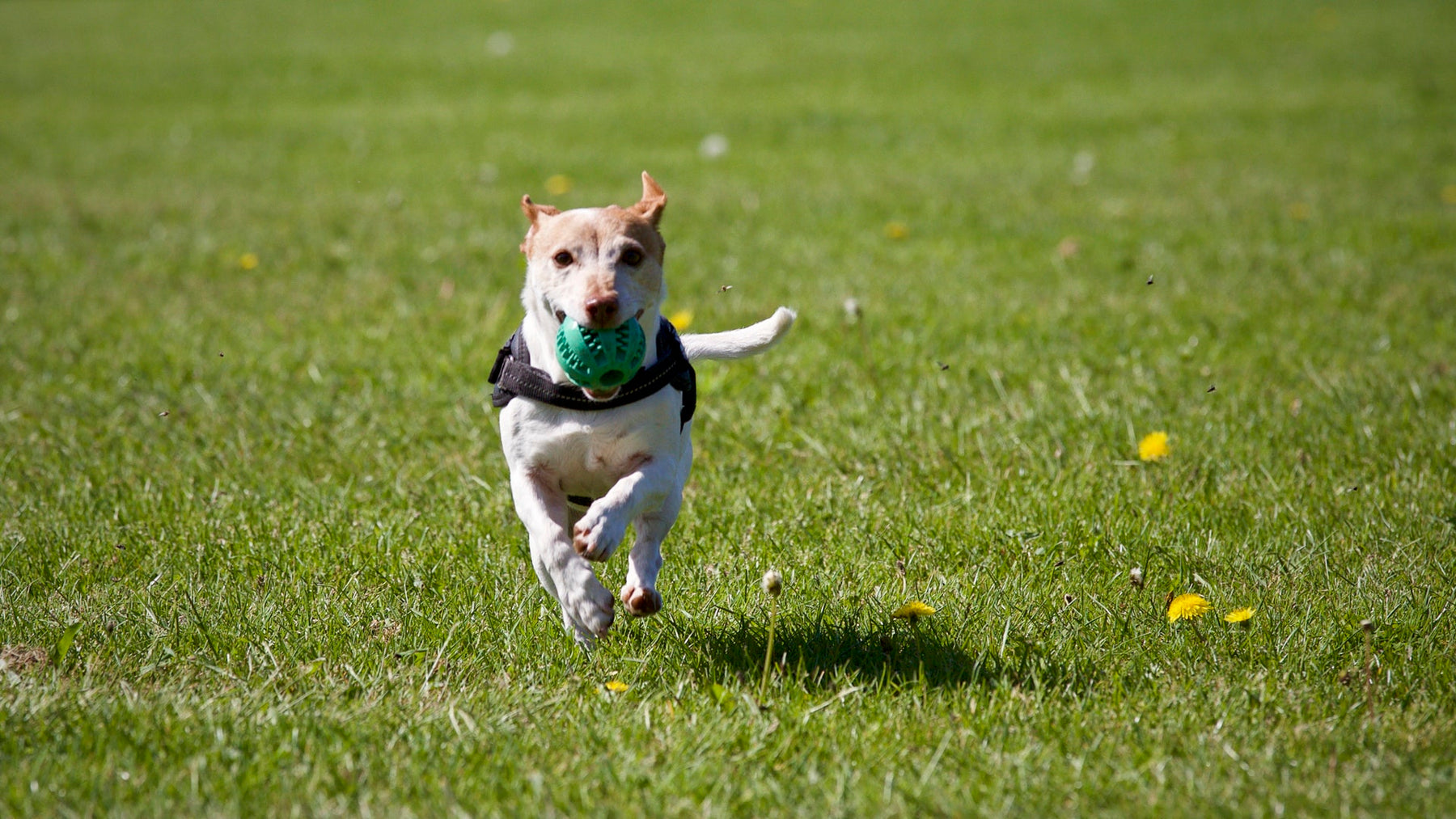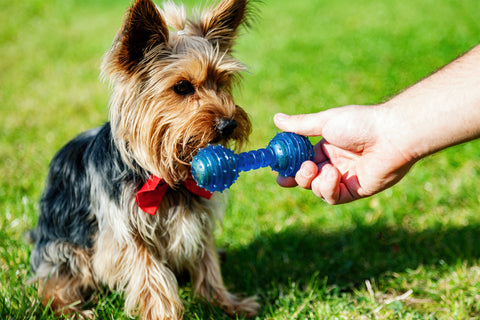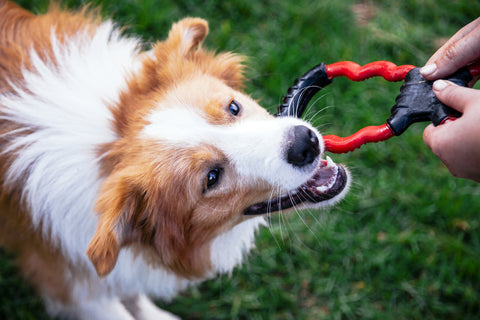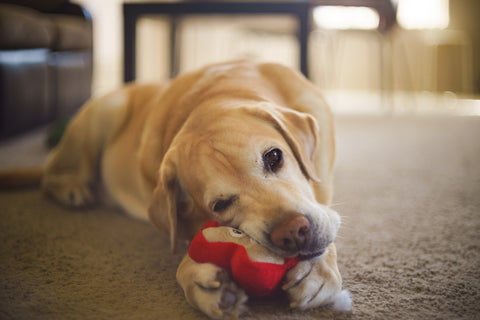
How to Teach Your Adult Dog to Love Their Toys
You’ve got the most amazing dog: walks are stress free, they respond eagerly to your cues, and they absolutely LOVE going on a sniffari in the yard or park.
But for whatever reason, your dog loses interest any time you bring out the toys. And if you work from home or have a huge list of chores on tap, this makes for a long and stressful day.
As sacred as pockets of free-time throughout the day are to you, playtime benefits your dog even more, and for several reasons:
- Mental stimulation during play burns off energy; meaning a tired, happy dog!
- Play can become an active reward for learning new things or good behavior.
- You can build (and reinforce) the bond with your dog through play.
- Hey... playing is fun! And fun increases your dog’s quality of life!
So, where does the lack of interest come from?
It’s really simple at the core: toys aren’t necessary to the survival of your dog. They don’t hold the same intrinsic value to them as food and water. All this means is that your dog will need to be shown how awesome and rewarding that squeaker ball or rope tug can be!
Doing so isn’t difficult with young pups who are fearless and eager to learn about their world. But as I scoured Facebook groups, subreddits, and other articles to figure out why my adult dog wasn’t playing with her toys like everyone else’s dog I see, I was shocked to find I wasn’t alone.
My first mistake was comparing my dog to other dogs, because I don’t know their life story or their training history. Beyond the root reason mentioned above, adult dogs who missed out on early socialization or grew up in a shelter might not know the joy that play can bring... and my girl is one of them.
If your dog is too, then you’re in the right place. Here’s how to get Fido feelin’ super fine about his toys!

Step 1: Introduce Toys Slowly
It takes time for your dog to learn to trust you, and sometimes even longer for them to understand the right ways to interact with both you and their new surroundings — especially if they’ve been rescued from a bad situation.
To start, leave one or two toys out for your dog to sniff at in passing. They might ignore them entirely at first, but eventually your dog will begin to show interest. For now, don’t shake or squeak the toy, get excited about it, or even show them where it is. Work on getting your dog used to the sound of the toy after they’re okay with its presence.
You do need to take your time with this, but if it’s been a day or two and your dog is still passing it by, try moving the toy to a place they frequent:
- A few feet away from water or food bowls
- Near the door where they eagerly await yard time or walks
- Spots they like to rest
The patience of this phase WILL pay off, and your dog will trade indifference for interest.
Step 2: Reward That Interest!
When your dog pauses at their toy with a lingering sniff or boop of the snoot, reward them right away — even if it’s just one or two seconds! Use soft praise and small bits of healthy treats. Trust me — it’ll be hard to contain your own excitement and resist initiating play, but it’s critical that you don’t rush through this step. That’s the mistake I made with my dog, and it took us a full month to get her remotely interested in her toys again.
Depending on the toy, there are a few ways to show your dog that these playthings equal great things:
- Kongs or treat balls can be stuffed or spread with your dog’s favorite foods, which is exactly what they’re meant for!
- Add some incentive to that flavored toy bone or ball by smearing it with peanut butter or dipping it in broth.
- Crush your dog’s training treats into tiny bits and sprinkle them onto plushie or rope toys.
The last tip was something I tried on a desperate whim and was the Holy Grail for my dog’s breakthrough!
Once your dog is constantly showing interest when their toys are brought out, or trying to find them if you haven’t, you’re ready for the fun stuff!

Step 3: It’s Time to Play!
Yep — I said it’s time for the fun stuff, but you still need to take it slow at first. Sit close to your dog and roll the ball, squeak the plushie, or shake the tug toy along the floor. Any time your dog tracks it with their eyes or dips in for a nip, praise them and give a treat.
This might only happen once or twice before they lose interest and wander off. Don’t get discouraged — and don’t force the play! Simply put the toys away and try again later.
Where step one took a long time with my dog, this phase passed quickly. You are the best judge of your furry friend, and you’ll be able to tell by their body language when it’s time to ramp things up! Here’s a few things I did to show my dog it’s okay to let loose with the toys:
- ACT A FOOL! Seriously. I’ll trot around our living room and up and down the hallway, wagging my butt. I’ll squeak the toy lightly and ask, “wanna play?” with a wiggle. This gets my dog excited every time without fail!
- Use their cues for the fun! If the above is still too intense for your dog, place them in a sit/stay. Let them watch you “hide” the toy, then release them with an excited “okay!” If your dog knows the “find it” cue, that’ll work, too. Remember the tip about crushing up treats to “dust” onto toys? That will help you here.
- End play before your dog gets bored! As hard as this is to do when you’re having fun, it’ll solidify the fun and excitement surrounding their toys. It also helps you establish rules: when playtime is done, then it’s time to settle.
Some games with toys have extra steps, like “come” and “drop it” to introduce your dog to fun stints of fetch. Incorporating training into play is always a plus!
Senior Dogs
Just like people, dogs have less energy as they age. Barring any health conditions diagnosed by your veterinarian, if your senior dog has lost interest in toys they used to love, this is natural.
Switch to toys that are more appropriate for dogs in their golden years, like plushies or softer chews. If this isn’t an option and you decide to fade out the toys, there are plenty of activities that’ll help your senior dog live out their best life.

Final Tips
Poet William Cowper penned:
“Variety is the very spice of life, that gives it all its flavor.”
Now that you’ve taught your adult dog how rewarding their toys are, keep things fun with some variety! Sure, some dogs will have their beloved toy they love to carry, snuggle, or sleep with, but when it comes to play that’s both mentally and physically engaging, giving your dog choices goes a long way.
Don’t allow your dog access to the same toys every day. The first month my dog was home she had a total of five toys. Snooooooore! Between expanding her collection and taking my time with the steps above, my dog goes NUTS the moment I say, “Toy time?”
Let them have a toy basket they can get to, and one they can’t. If they don’t have a toy basket and you want to introduce them to one, the crushed treats work well here! Sprinkle them in the bottom of the basket with a few of their favorite toys.
This also encourages your dog to pull their toys out without your urging, which will go far when you need that extra few minutes for chores. By rotating what toys are in the bin they can get to, the experience will always be exciting!
You can still do this without any kind of toy bin, too. Just keep the toys in a closet or drawer and choose different ones each day. If you want to let your pal choose what to play with, rotate what toys are in the drawer or closet to keep things interesting.
Combine those toys! I’ve stuck tennis balls into larger, rubber holey balls, and put a dinosaur chew bone in a plushie donut toy. Dog toy mash-ups will be hit or miss, but I promise they’ll be fun either way!
Playing with toys isn’t a requirement for dogs, nor is it something that every dog does naturally. It will take a little work and a lot of patience, but the first time you watch your pal light up when you pull out their favorites is worth the time you’ve invested.
How long did it take your dog to learn to love their toys? Let us know - we love connecting with our readers!
Did you enjoy this post? Please give it a like and share it with your friends! Thanks! 🐶❤️🐾
